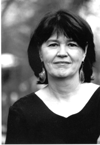 Rosemary Sullivan
Rosemary Sullivan
Fiction Antholgies
Rosemary Sullivan's The Oxford Book of Stories by Canadian Women in English (Oxford University Press, 608 pages, $29.95 paper, ISBN: 0195414551) differs markedly from her previous two anthologies: Stories by Canadian Women (1984) and More Stories by Canadian Women (1987). It contains short stories by English-Canadian women only; it is purportedly representative of regional differences across Canada; and, it encompasses a broader time span¨"over a century and a half of writing."
Readers may expect to find a fairly standard-representation of the writings of such Canadian best-sellers as Margaret Atwood ("Bluebeard's Egg"), Alice Munro ("The Albanian Virgin") and Carol Shields ("The Orange Fish"), and an emphasis on mid- to late- twentieth-century writing. Not only its focus, but also the collection's tone has changed: Sullivan makes a clear distinction between "those days"¨approximately a decade earlier when she edited the other two anthologies, when "excellent women writers were excluded", and when "no effort had yet been made to offer a historical overview of the contribution of Canadian women to the short story genre"¨and nowadays, when such an anthology is "no longer a political statement about exclusion."
Indeed, the proliferation of short-story anthologies by Canadian women in the 1980s and 1990s indicates the recent efforts to draw attention to women's writing. Aspiring Women: Short Stories by Canadian Women (University of Ottawa Press, 1993), New Women: Short Stories by Canadian Women (University of Ottawa Press, 1991), Frictions: Stories by Women (Second Story Press, 1989), and Imagining Women (The Women's Press, 1988) are just a few examples. The spirit of Sullivan's anthology differs because, "in these days", the stories "reflect a new sense of cultural authority. It is obvious that women can never be shunted to the margins again." In other words, this anthology is not an act of recuperation, as much as it is a celebration of, and a statement of confidence in, women's writing.
Despite such a celebratory attitude¨indeed, there is cause for it¨Sullivan's most recent collection is not without its difficulties, apart from its Ontario-centric inclination and rather conservative selection of stories. Why is the emphasis on twentieth-century writers? Only three writers in the entire collection are pre-1900 and literary big-league players who have had work anthologized or reprinted a number of times: Catharine Parr Traill, Sara Jeanette Duncan and E.Pauline Johnson. The literary outputs of the latter two straddle the nineteenth and twentieth centuries. The remaining forty-seven began writing and were published in the twentieth century. Why not include such nineteenth-century writers as Susan Frances Harrison and Kate Simpson Hayes, who are somewhat less well known and merit attention?
The collection, then, is less a cross-section of women's writing over the past 150 years, and more a selection of writing from the 1900s. Sullivan justifies this selection when she asserts that she has represented authors who "have published at least one collection of short stories"; yet some of the writers (such as Marlene Nourbese Philip and Aritha van Herk), despite their excellence, have not published a short-story collection (unless a collection of essays is considered an equivalent). Although compiling any literary history is an arduous task because it requires focus and therefore demands the omission of some fine writers, this criterion is puzzling and unaccountable, if not arbitrary, given both the publishing market and the generic interests of the nineteenth century. Many women writers before the 1900s would have found opportunities for publishing more frequently in magazines than in book form; in addition, fiction in the form of the novel would have found an audience¨and thus a publisher¨much more easily than in the form of a short-story collection.
Sullivan, in effect, is perpetuating the exclusion of women writers who already had limitations imposed by societal convention, who would have found great difficulty in finding a publisher for their short stories by virtue of their gender and audience expectation, and who continue to be marginalized and obscured. In Writing Women's Literary History, Margaret J.M. Ezell has argued that "feminist literary history has reached the level of critical development and self-confidence necessary" to become self-critical. The fact that Sullivan's anthology is uncontroversial is a testimony to, and justifies her confidence in, women's writing and in its development. The other glaring fact is that there still remains much to be done in the recovery of women's writing in Canadian literary history. ˛
Linda M.Morra